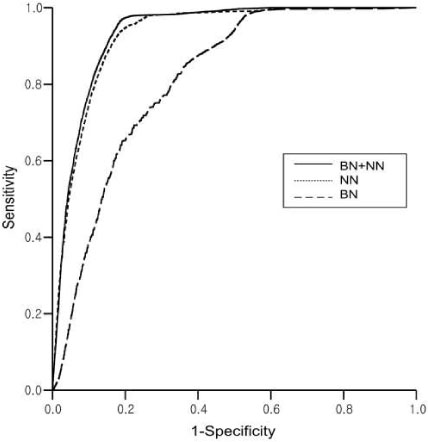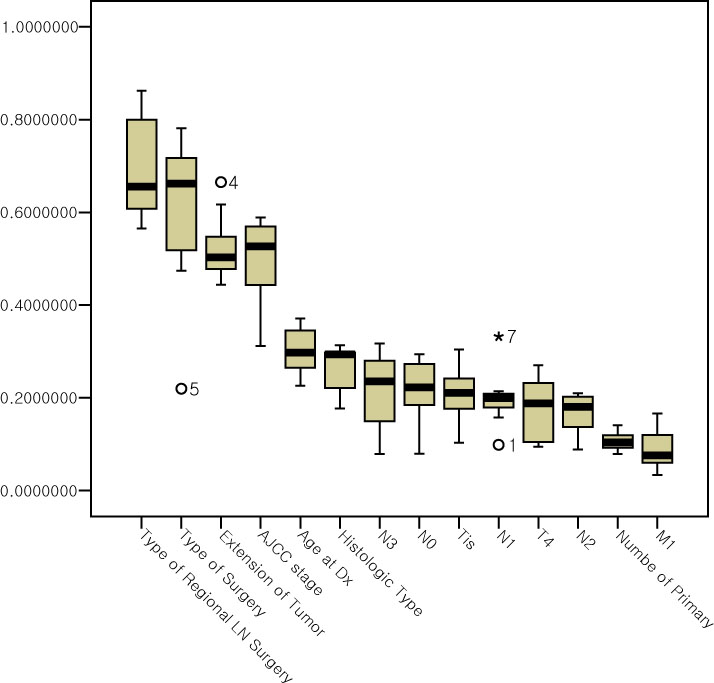J Korean Soc Med Inform.
2009 Mar;15(1):49-57.
A Hybrid Bayesian Network Model for Predicting Breast Cancer Prognosis
- Affiliations
-
- 1Department of Medical Informatics, Ajou University School of Medicine, Korea. veritas@ajou.ac.kr
- 2Division of Bio-Medical Informatics, Center for Genome Science, National Institute of Health, KCDC, Korea.
Abstract
OBJECTIVE
Breast cancer is one of the most common cancers affecting women. Both physicians and patients have concerned about breast cancer survivability. Many researchers have studied the breast cancer survivability applying artificial nerural network model (ANN). Usually ANN model outperformed in classification of breast cancer survivability than other models such as logistic regression, Bayesian network (BN), or decision tree models. However, physicians in the fields hesitate to use ANN model, because ANN is a black-box model, and hard to explain the classification result to patients. In this study, we proposed a hybrid model with a degree of the accuracy and interpretation by combining the ANN for accuracy and BN for interpretation.
METHODS
We developed an artificial neural network, a Bayesian network, and a hybrid Bayesian network model to predict breast cancer prognosis. The hybrid model combined the artificial neural network and the Bayesian network to obtain a good estimation of prognosis as well as a good explanation of the results. The National Cancer Institute's SEER program public-use data (1973-2003) were used to construct and evaluate the proposed models. Nine variables, which are clinically acceptable, were selected for input to the proposed models' nodes. A confidence value of the neural network served as an additional input node to the hybrid Bayesian network model. Ten iterations of random subsampling were performed to evaluate performance of the models.
RESULTS
The hybrid BN model achieved the highest area under the curve value of 0.935, whereas the corresponding values of the neural network and Bayesian network were 0.930 and 0.813, respectively. The neural network model achieved the highest prediction accuracy of 88.8% with a sensitivity of 93.7% and a specificity of 85.4%. The hybrid Bayesian network model achieved a prediction accuracy of 87.2% with a sensitivity of 93.3% and a specificity of 83.1%. The results of the hybrid Bayesian network model were very similar to the neural network model.
CONCLUSION
In the experiments, the hybrid model and the ANN model outperformed the Bayesian network model. The proposed hybrid BN model for breast cancer prognosis predictin may be useful for clinicians in the medical fields, as the model provides both high degree of performance inherited from ANN and good explanation power from BN.
Keyword
MeSH Terms
Figure
Reference
-
1. Hankey BF, Ries LA, Edwards BK. The surveillance, epidemiology, and end results program: a national resource. Cancer Epidemiol Biomarkers Prev. 1999. 8(12):1117–1121.2. Minino AM, Heron MP, Smith BL. Deaths: preliminary data for 2004. Natl Vital Stat Rep. 2006. 54(19):1–49.3. Moore DH, Moore DH 2nd, Moore CT. Breast carcinoma etiological factors. Advances in cancer research. 1983. 40:189–253.
Article4. Skolnick MH, Cannon-Albright LA. Genetic predisposition to breast cancer. Cancer. 1992. 70(6):Suppl. 1747–1754.
Article5. Newcomb PA. Lactation and breast cancer risk. Journal of mammary gland biology and neoplasia. 1997. 2(3):311–318.6. Newcomb PA, Egan KM, Titus-Ernstoff L, et al. Lactation in relation to postmenopausal breast cancer. American journal of epidemiology. 1999. 150(2):174–182.
Article7. Brenin DR, Manasseh DM, El-Tamer M, et al. Factors correlating with lymph node metastases in patients with T1 breast cancer. Ann Surg Oncol. 2001. 8(5):432–437.
Article8. Kinne DW. Staging and follow-up of breast cancer patients. Cancer. 1991. 67(4):Suppl. 1196–1198.
Article9. Kinne DW. Axillary clearance in operable breast cancer: still a necessity? Recent results in cancer research Fortschritte der Krebsforschung. 1998. 152:161–169.
Article10. Moore MP, Kinne DW. Is axillary lymph node dissection necessary in the routine management of breast cancer? Yes. Important advances in oncology. 1996. 245–250.11. Rosen PP, Groshen S, Kinne DW. Prognosis in T2N0M0 stage I breast carcinoma: a 20-year follow-up study. J Clin Oncol. 1991. 9(9):1650–1661.
Article12. Fisher B, Redmond C, Poisson R, et al. Eight-year results of a randomized clinical trial comparing total mastectomy and lumpectomywith orwithout irradiation in the treatment of breast cancer. The New England journal of medicine. 1989. 320(13):822–828.
Article13. Galea MH, Blamey RW, Elston CE, Ellis IO. The Nottingham Prognostic Index in primary breast cancer. Breast cancer research and treatment. 1992. 22(3):207–219.
Article14. McGuire WL. Prognostic factors for recurrence and survival in human breast cancer. Breast cancer research and treatment. 1987. 10(1):5–9.
Article15. Slamon DJ, Clark GM, Wong SG, Levin WJ, Ullrich A, McGuire WL. Human breast cancer: correlation of relapse and survival with amplification of the HER-2/neu oncogene. Science. 1987. 235(4785):177–182.
Article16. Tiezzi DG, Andrade JM, Ribeiro-Silva A, Zola FE, Marana HR, Tiezzi MG. HER-2, p53, p21 and hormonal receptors proteins expression as predictive factors of response and prognosis in locally advanced breast cancer treated with neoadjuvant docetaxel plus epirubicin combination. BMC cancer. 2007. 7:36.
Article17. Burke HB, Goodman PH, Rosen DB, et al. Artificial neural networks improve the accuracy of cancer survival prediction. Cancer. 1997. 79(4):857–862.
Article18. Choi JW. Development of Breast Cancer Predication Model Using Neural Network. J Korean Soc Med Inform. 2003. 4(1):83–87.
Article19. Lee SM. Comparisons of predictive modeling techniques for breast cancer in Korean women. J Kor Soc Med Informatics. 2008. 14(1):37–44.
Article20. Lundin M, Lundin J, Burke HB, Toikkanen S, Pylkkanen L, Joensuu H. Artificial neural networks applied to survival prediction in breast cancer. Oncology. 1999. 57(4):281–286.
Article21. Delen D, Walker G, Kadam A. Predicting breast cancer survivability: a comparison of three data mining methods. Artificial intelligence in medicine. 2005. 34(2):113–127.
Article22. Berner ES. Clinical Decision Support Systems. 2007. New York: Springer.23. SEER Cancer Statistics Review. Surveillance, Epidemiology, and End Results (SEER) Program. National Cancer Institute, Surveillance Research Program, Cancer Statistics Branch: Public-Use Data (1973-2003). released April 2006, based on the November 2005 submission. (www.seer.cancer.gov).24. Rumelhart DE, McClelland JL. Group CPR. Parallel distributed processing: explorations in themicrostructure of cognition vol. 2: psychological and biological models. 1986. Cambridge, MA: MIT Press.25. Jensen FV. An Introduction to Bayesian Network. 1997. New York: Springer Verlag.
- Full Text Links
- Actions
-
Cited
- CITED
-
- Close
- Share
- Similar articles
-
- Causal Inference Network of Genes Related with Bone Metastasis of Breast Cancer and Osteoblasts Using Causal Bayesian Networks
- Application of a Bayesian Network to Predict Hospitalization among HIV Adults
- A comparison of breast cancer survival among young, middle-aged, and elderly patients in southern Iran using Cox and empirical Bayesian additive hazard models
- Bayesian Network Approaches to Health Services Research
- Development of Breast Cancer Predication Model Using Neural Networks




